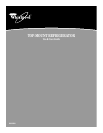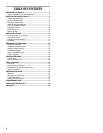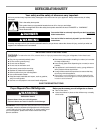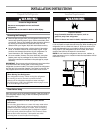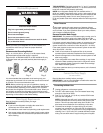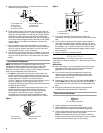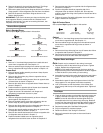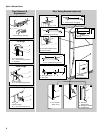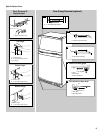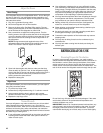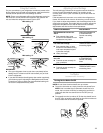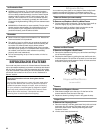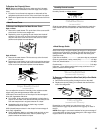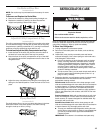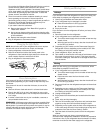
5
Electrical Requirements
Before you move your refrigerator into its final location, it is
important to make sure you have the proper electrical
connection:
Recommended Grounding Method
Plug 1: A 115 Volt, 60 Hz., AC only 15 or 20 ampere fused,
grounded (earthed) electrical supply is required.
Plugs 2 and 3: A 220/240 Volt/50 Hz or 220 Volt/60Hz AC only
10 ampere fused and grounded (earthed) electrical supply is
required.
It is recommended that a separate circuit serving only your
refrigerator be provided. Use an outlet that cannot be turned off
by a switch. Do not use an extension cord.
NOTE: Before performing any type of installation, cleaning, or
removing a light bulb, turn the control, (Thermostat, Refrigerator
or Freezer Control depending on the model) to OFF and then
disconnect the refrigerator from the electrical source. When you
are finished, reconnect the refrigerator to the electrical source
and reset the control (Thermostat, Refrigerator or Freezer Control
depending on the model) to the desired setting.
Water Supply Requirements
Read all directions carefully before you begin.
IMPORTANT:
■ If you turn the refrigerator on before the water line is
connected, turn the ice maker OFF.
■ All installations must meet local plumbing code requirements.
■ Use copper tubing and check for leaks. Install copper tubing
only in areas where the household temperatures will remain
above freezing.
TOOLS NEEDED: Flat-blade screwdriver, ⁷⁄₁₆" and ¹⁄₂" open-end
wrenches or two adjustable wrenches, ¹⁄₄" nut driver and drill bit,
hand drill or electric drill (properly grounded).
NOTE: Your refrigerator dealer has a kit available with a ¹⁄₄"
(6.35 mm) saddle-type shutoff valve, a union, and copper tubing.
Before purchasing, make sure a saddle-type valve complies with
your local plumbing codes. Do not use a piercing-type or ³⁄₁₆"
(4.76 mm) saddle valve which reduces water flow and clogs more
easily.
Water Pressure
A cold water supply with water pressure of between 30 and
120 psi (207 - 827 kPa) is required to operate the water dispenser
and ice maker. If you have questions about your water pressure,
call a licensed, qualified plumber.
Reverse Osmosis Water Supply
IMPORTANT: The pressure of the water supply coming out of a
reverse osmosis system going to the water inlet valve of the
refrigerator needs to be between 30 and 120 psi (207 - 827 kPa).
If a reverse osmosis water filtration system is connected to your
cold water supply, the water pressure to the reverse osmosis
system needs to be a minimum of 40 to 60 psi (276 - 414 kPa).
If the water pressure to the reverse osmosis system is less than
40 to 60 psi (276 - 414 kPa):
■ Check to see whether the sediment filter in the reverse
osmosis system is blocked. Replace the filter if necessary.
■ Allow the storage tank on the reverse osmosis system to refill
after heavy usage.
■ If your refrigerator has a water filter cartridge, it may further
reduce the water pressure when used in conjunction with a
reverse osmosis system. Remove the water filter cartridge.
See “Water Filtration System.”
If you have questions about your water pressure, call a licensed,
qualified plumber.
Connect the Water Supply
(on some models)
Read all directions carefully before you begin.
IMPORTANT: If you turn the refrigerator on before the water line
is connected, turn the ice maker OFF.
Connecting to Water Line:
1. Unplug refrigerator or disconnect power.
2. Turn OFF main water supply. Turn ON nearest faucet long
enough to clear line of water.
3. Find a ¹⁄₂" (1.27 cm) to 1¹⁄₄" (3.18 cm) vertical COLD water
pipe near the refrigerator.
NOTE: Horizontal pipe will work, but the following procedure
must be followed: Drill on the top side of the pipe, not the
bottom. This will help keep water away from the drill. This
also keeps normal sediment from collecting in the valve.
4. To determine the length of copper tubing you will need,
measure from connection on lower left rear of refrigerator to
water pipe. Add 7 ft (2.1 m) to allow for moving refrigerator for
cleaning. Use ¹⁄₄" (6.35 mm) O.D. (outside diameter) copper
tubing. Be sure both ends of copper tubing are cut square.
WARNING
Electrical Shock Hazard
Plug into a grounded (earthed) outlet.
Do not remove ground prong.
Do not use an adapter.
Do not use an extension cord.
Failure to follow these instructions can result in death,
fire, or electrical shock.
Plug 1
Plug 2
Plug 3



